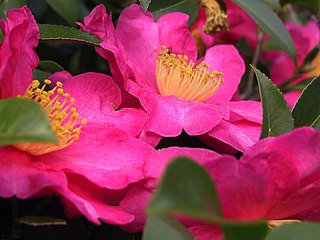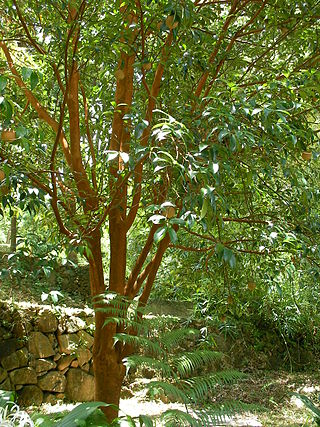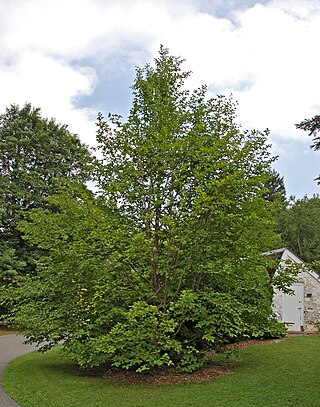
Tea is an aromatic beverage prepared by pouring hot or boiling water over cured or fresh leaves of Camellia sinensis, an evergreen shrub native to East Asia which probably originated in the borderlands of southwestern China and northern Myanmar. Tea is also made, but rarely, from the leaves of Camellia taliensis. After plain water, tea is the most widely consumed drink in the world. There are many different types of tea; some have a cooling, slightly bitter, and astringent flavour, while others have profiles that include sweet, nutty, floral, or grassy notes. Tea has a stimulating effect in humans primarily due to its caffeine content.

Camellia is a genus of flowering plants in the family Theaceae. They are found in tropical and subtropical areas in eastern and southern Asia, from the Himalayas east to Japan and Indonesia. There are more than 220 described species. Camellias are popular ornamental, tea and woody-oil plants that have been cultivated throughout the world for centuries. To date, over 26,000 cultivars, with more than 51,000 cultivar names including synonyms, have been registered or published.
The Camellia Bowl was an annual college football postseason game in Sacramento, California, which is nicknamed the Camellia City. It was held sixteen times at Hughes Stadium, from 1961 through 1975, and once more in 1980.

White tea may refer to one of several styles of tea which generally feature young or minimally processed leaves of the Camellia sinensis plant.

Theaceae, the tea family, is a family of flowering plants comprising shrubs and trees, including the economically important tea plant, and the ornamental camellias. It can be described as having from seven to 40 genera, depending on the source and the method of circumscription used. The family Ternstroemiaceae has been included within Theaceae; however, the APG III system of 2009 places it instead in Pentaphylacaceae. Most but not all species are native to China and East Asia.

Camellia sinensis is a species of evergreen shrub or small tree in the flowering plant family Theaceae. Its leaves, leaf buds, and stems can be used to produce tea. Common names include tea plant, tea shrub, and tea tree.

Mount Parker is the second-highest peak on Hong Kong Island, after Victoria Peak. It is the 40th-highest peak in the territory of Hong Kong.

Camellia japonica, known as common camellia, or Japanese camellia, is a species of Camellia, a flowering plant genus in the family Theaceae. There are thousands of cultivars of C. japonica in cultivation, with many colors and forms of flowers. Despite its common name, it is native to China, not Japan. The cultivation of Camellia japonica also started in China. Its widespread cultivation can be traced back to the Song Dynasty, when 15 varieties of Camellia japonica were recorded in literature. It was later introduced to Japan. It grows in forests, at altitudes of around 300–1,100 metres (980–3,600 ft).

Tea seed oil is an edible plant oil. It is obtained from the seeds of Camellia oleifera.

Fangchenggang is a prefecture-level city in the south of Guangxi Zhuang Autonomous Region, People's Republic of China. The city was formerly called "Fangcheng Pan-Ethnicities Autonomous County".

Mount Nicholson is a 430 m (1,411 ft) tall mountain located in Wan Chai District, on Hong Kong Island, Hong Kong. The hill is believed to be named for Hong Kong Volunteer Corps Adjunct Lieutenant W.C.A. Nicholson.

Camellia crapnelliana, Crapnell's camellia, is a flowering Camellia native to Hong Kong and other parts of south-eastern China.

Camellia sasanqua, with common name sasanqua camellia, is a species of Camellia native to southern Japan. It is usually found growing up to an altitude of 900 m (3,000 ft).

Camellia reticulata is a species of flowering plant in the tea family Theaceae, native to southwestern China, in Yunnan and Sichuan Provinces.

Stewartia pseudocamellia, also known as Korean stewartia, Japanese stewartia, or deciduous camellia, is a species of flowering plant in the family Theaceae, native to Japan and Korea.

Camellia petelotii is a species of plant in the family Theaceae. It is found in China and Vietnam. It may be called the golden camellia and synonyms include C. chrysantha and Camellia nitidissima. The golden camellia originated 170 million years ago, it is a first-class nationally protected plant in China. The golden camellia is extremely demanding on the growth environment, and its genes are extremely difficult to replicate, once transplanted, it will die or genetically mutate. Therefore, in 1986, the Golden Camellia National Nature Reserve was built in Fangcheng, Guangxi, with a total area of 9195.1 hectares.

Pieris japonica, the Japanese andromeda or Japanese pieris, is a species of flowering plant in the heath family Ericaceae. It is native to eastern China, Taiwan, and Japan, where it grows in mountain thickets. This medium-sized evergreen shrub or tree is widely cultivated in gardens.

Stewartia sinensis, the Chinese stewartia, is a species of flowering plant in the camellia family Theaceae, native to central and eastern China. It is typically a small deciduous tree, growing to about 9 m (30 ft) tall. In its native forests, S. sinensis has been known to achieve a maximum height of 20 m (66 ft) tall by 7 m (23 ft) broad.

The Cadillac CT4 is a sedan manufactured and marketed by Cadillac. It replaced the Cadillac ATS sedan and sits below the CT5 in Cadillac's lineup. The CT4-V was unveiled first on May 30, 2019, followed by the standard CT4 four months later. Cadillac assembles the CT4 at the Lansing Grand River Assembly plant in Lansing, Michigan, as well as in SAIC-GM Jinqiao plant in China.

Camellia fraterna is a species of flowering plant in the tea family Theaceae, native to southeastern China. A perennial shrub from 1 to 4 m tall, it is typically found in thickets and forests at elevations of 100 to 1,100 m. It has been crossed with other members of Camellia to produce a number of hybrid cultivars, including 'Tiny Princess' with Camellia cuspidata.


















